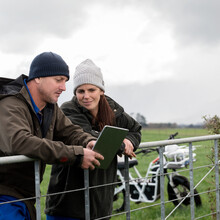Eco-sourcing Plants for restoration projects
This QE11 factsheet provides advice for landowners with QEII covenants on how to eco-source plants for restoration projects.
PROVIDER
QEII
Landscaping with Native Plants
Find out more about growing native plants at your place.
VISIT SITE
PROVIDER
Southland Community Nursery
EnviroWalk
The EnviroWalk app is an easy to use tool that helps farmers quickly assess environmental risks across the farm. When areas for improvement are identified, the app lists actions that can be selected to form a customised action plan. Plans are saved and can be downloaded, printed and updated at any time.
PROVIDER
DairyNZ
Waterway Technical Notes
Carbon Calculator for Native Trees
This tool allows you to work out how much carbon your planted native forest is storing over a defined period of time. It also allows you to determine how many native shrubs and trees you will need to plant to off-set your carbon footprint.
PROVIDER
Tane's Tree Trust
Fencing Waterways
Fencing waterways protects freshwater from nutrients, effluent and sediment by excluding stock and creating a buffer between water and the land. Fencing will help to maintain and improve water quality and create a habitat for birds and freshwater species.
PROVIDER
DairyNZ
Planting Waterways
Using the right plants and techniques will help maximise the success of riparian planting and ensure you are getting value for money by getting it right first time.
PROVIDER
DairyNZ
Getting Riparian Planting right in Southland
A guide to riparian planting options and costs
There is an extensive range of riparian planting options available to improve waterway health and add other values, like bee food, stock shelter and landscape aesthetics. Whatever you choose, your plantings require careful consideration to improve plant survival, reduce problems in the future as plants grow and to achieve the desired outcomes.
PROVIDER
Environment Southland
A guide to shelter planting and costs
There is an extensive range of shelter planting options available to achieve stock shelter and increased grass or crop production, while adding other values like bee food and landscape aesthetics. Whatever you choose, your plantings require careful consideration to improve plant survival, reduce problems in the future as plants grow and to achieve the desired outcomes.
PROVIDER
Environment Southland
A guide to the benefits of planting willows
Willow trees are a valuable asset on the farm and to the Southland region, performing many beneficial services like erosion control, stock shelter, bee food, bird habitat and providing resources like woodchip, firewood and honey.
PROVIDER
Environment Southland
Creating Riparian Zones
The strip of land beside a waterway is a called the riparian zone and it is a crucial buffer between land and water. Some riparian zones are grassed, but ideally they are home to many species of plants that existed prior to land development. Effective riparian zones include plants that can deal with floods and seasonal wet and dry periods, and will improve the health of your waterways.
PROVIDER
Environment Southland
Riparian Plants for Southland
A guide to plant species suitable for riparian planting in Southland
PROVIDER
Environment Southland
Shelterbelts
Most shelterbelts in Southland serve mainly as a physical barrier to reduce wind speed and improve the local micro climate. However, shelterbelts can also provide important habitats for native insects and birds. Find out about the benefits of using native trees for your shelterbelt and see our list of recommended species.
PROVIDER
Southland Community Nursery
Trees that count - Otago Southland guide
Make your native bush sing: Biodiversity protection & enhancement
Options to help manage and protect native bush areas on deer farms including planting and protecting from pests
PROVIDER
DINZ
Identifying weeds in riparian zones of Southland
There are some common weeds found growing along waterways in Southland. Find out what they look like and see our tips for control.
PROVIDER
Environment Southland
Pest animals in riparian zones
Good pest management is key to the success of your riparian planting project. Riparian zones can be great for attracting wildlife, however, they can also be a smorgasbord of tasty treats and an inviting environment for hares, rabbits and possums.
PROVIDER
Environment Southland
Choose the right tree for your site
Trees work well when integrated into the landscape to complement and diversify existing land uses. Tree planting needs to be well planned by considering the long-term maintenance and end-use of the trees. If on farms, then take a whole farm approach and look at your land’s potential, water resources, environmental factors and terrain.
PROVIDER
Canopy
EnviroWalk
The EnviroWalk app is an easy to use tool that helps farmers quickly assess environmental risks across the farm. When areas for improvement are identified, the app lists actions that can be selected to form a customised action plan. Plans are saved and can be downloaded, printed and updated at any time.
PROVIDER
DairyNZ

